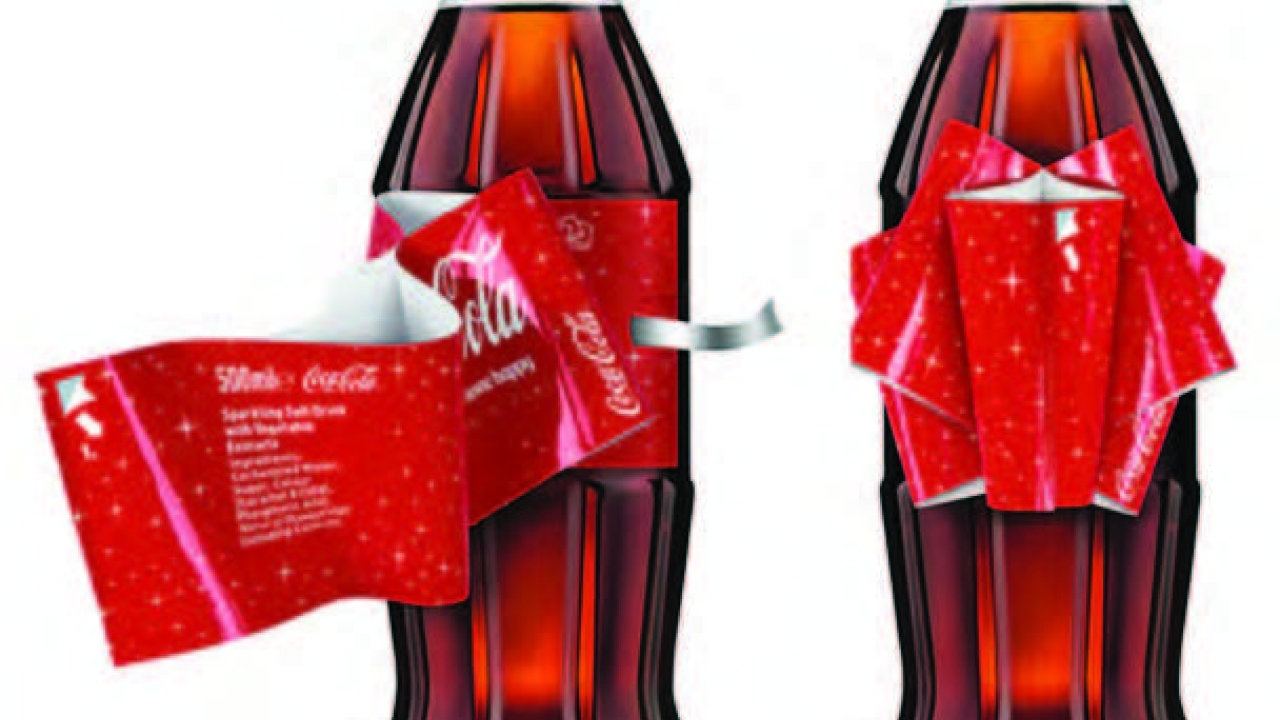Bow label is new Coca-Cola breakthrough

Coca-Cola has introduced a new marketing concept to excite European consumers – a label which forms into a bow when a concealed ribbon is pulled.
The promotion was timed for the Christmas market and has not only boosted sales, but generated a high level of interest and engagement on social media.
Driven by Coca-Cola Europe’s packaging innovation manager Gregory Bentley, bow label involved close co-operation between Coca-Cola bottlers, label converters Eshuis and Constantia, and a bespoke machinery developer. The project built on the experience gained during the planning and execution of Share-a-Coke (SAC) in previous years, although this time there is no variably printed element.
Demonstrating the power of global thinking, the bow label concept was first developed in Latin America by a creative agency, which produced a few thousand hand-applied fabric labels.
‘They had to go around the bottle more than once, and we sold them online,’ recalls Gregory Bentley.
‘That was fine for small volumes, but I was sure this could be done on a large scale, as it was in principle a flat label which could be made from any material. So the concept came from marketing, but moving it to a large-scale commercial operation was something we pushed.’
Bentley’s first call was to Peter Overbeek, managing director of Dutch converter Eshuis, which had pulled together the organization of the whole Share-a-Coke project.
‘I sent Peter a bit of paper wrapped round a can and was clear about the key challenges: can we actually manufacture a label this complex, with three layers and incorporating different types of material? Can that reel of labels then be applied? And does it work when it gets to consumer? It had to do all three before it could work commercially.’
Recalls Eshuis managing director Peter Overbeek, ‘This project started in April 2013 when Gregory Bentley from TCCC showed in Eshuis a video and a PowerPoint presentation from Coca Cola Colombia with beautiful but expensive handmade bow labels. He asked me if we were able to create these kinds of labels for industrial application in significant volumes for high-speed bottling lines.
‘I told him – after consulting my team – yes, we think we can do this. We did many trials with parts of the label just to get a clear idea of specifications and how we could do it on a larger scale. We also invested in equipment with tools specially developed for this purpose.’
As with the Share-a-Coke project, the labels would need to go through Coca-Cola bottlers’ existing label applicator lines without disruption. So the labels must be supplied on a reel and cut through and the COF would need to work on existing hot melt glue lines at 120m/min with labels no bigger than 38mm.
‘In Europe we have seen many bottlers, and if you look at their operation and their high-speed machines, these are not all 100 percent the same,’ says Peter Overbeek. ‘Even if they are using the same equipment from the same supplier, the operational settings are not always standardized and these settings are not easy to change if we simply tell them to. That is not the way it works. But on the other hand we cannot use different specs of the same size bow labels for different bottling companies; this would make the project much too complex. So to overcome this issue we needed to instruct and guide the bottlers how to apply this kind of label on their labeling machines with the best possible results, without losing productivity or creating extra waste.’
At the outset, Gregory Bentley was only 50/50 convinced the project could work. ‘Eshuis put a lot on the line, because we can’t confirm orders until a project is ready for production. Eshuis’ business is not wraparound, but they knew enough to know how to make it happen with the support and knowhow of Constantia. I remained optimistic, and by last year I was 85 percent confident of success.’
Workflow
To produce the bow labels, wraparound film is first gravure printed front and back by Constantia, after which the rolls are slit into two narrower reels. At Eshuis the reels are brought together, a foil pull strip inserted, and varnish and pattern adhesive applied. Clever design of the adhesive pattern forces the BOPP into a bow shape when the foil strip is pulled.
The pull strip itself is revealed when a die-cut segment is pulled away as the consumer removes the label from the bottle.
Stay up to date
Subscribe to the free Label News newsletter and receive the latest content every week. We'll never share your email address.


